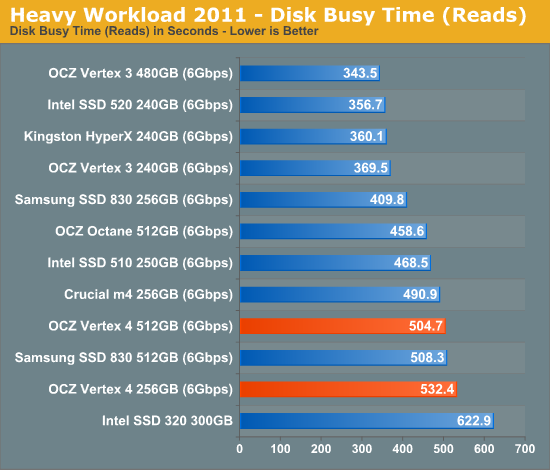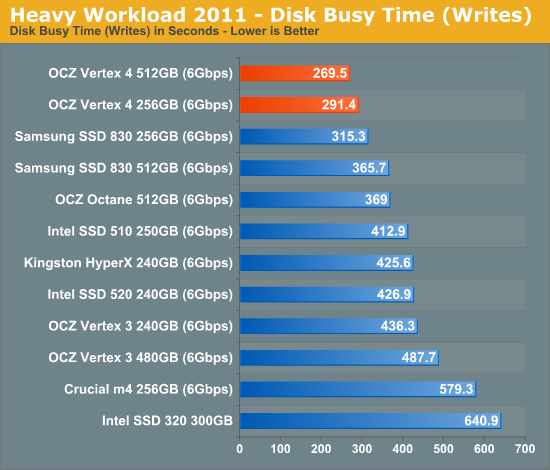OCZ Vertex 4 Review (256GB, 512GB)
by Anand Lal Shimpi on April 4, 2012 9:00 AM ESTAnandTech Storage Bench 2011
Two years ago we introduced our AnandTech Storage Bench, a suite of benchmarks that took traces of real OS/application usage and played them back in a repeatable manner. I assembled the traces myself out of frustration with the majority of what we have today in terms of SSD benchmarks.
Although the AnandTech Storage Bench tests did a good job of characterizing SSD performance, they weren't stressful enough. All of the tests performed less than 10GB of reads/writes and typically involved only 4GB of writes specifically. That's not even enough exceed the spare area on most SSDs. Most canned SSD benchmarks don't even come close to writing a single gigabyte of data, but that doesn't mean that simply writing 4GB is acceptable.
Originally I kept the benchmarks short enough that they wouldn't be a burden to run (~30 minutes) but long enough that they were representative of what a power user might do with their system.
Not too long ago I tweeted that I had created what I referred to as the Mother of All SSD Benchmarks (MOASB). Rather than only writing 4GB of data to the drive, this benchmark writes 106.32GB. It's the load you'd put on a drive after nearly two weeks of constant usage. And it takes a *long* time to run.
1) The MOASB, officially called AnandTech Storage Bench 2011 - Heavy Workload, mainly focuses on the times when your I/O activity is the highest. There is a lot of downloading and application installing that happens during the course of this test. My thinking was that it's during application installs, file copies, downloading and multitasking with all of this that you can really notice performance differences between drives.
2) I tried to cover as many bases as possible with the software I incorporated into this test. There's a lot of photo editing in Photoshop, HTML editing in Dreamweaver, web browsing, game playing/level loading (Starcraft II & WoW are both a part of the test) as well as general use stuff (application installing, virus scanning). I included a large amount of email downloading, document creation and editing as well. To top it all off I even use Visual Studio 2008 to build Chromium during the test.
The test has 2,168,893 read operations and 1,783,447 write operations. The IO breakdown is as follows:
| AnandTech Storage Bench 2011 - Heavy Workload IO Breakdown | ||||
| IO Size | % of Total | |||
| 4KB | 28% | |||
| 16KB | 10% | |||
| 32KB | 10% | |||
| 64KB | 4% | |||
Only 42% of all operations are sequential, the rest range from pseudo to fully random (with most falling in the pseudo-random category). Average queue depth is 4.625 IOs, with 59% of operations taking place in an IO queue of 1.
Many of you have asked for a better way to really characterize performance. Simply looking at IOPS doesn't really say much. As a result I'm going to be presenting Storage Bench 2011 data in a slightly different way. We'll have performance represented as Average MB/s, with higher numbers being better. At the same time I'll be reporting how long the SSD was busy while running this test. These disk busy graphs will show you exactly how much time was shaved off by using a faster drive vs. a slower one during the course of this test. Finally, I will also break out performance into reads, writes and combined. The reason I do this is to help balance out the fact that this test is unusually write intensive, which can often hide the benefits of a drive with good read performance.
There's also a new light workload for 2011. This is a far more reasonable, typical every day use case benchmark. Lots of web browsing, photo editing (but with a greater focus on photo consumption), video playback as well as some application installs and gaming. This test isn't nearly as write intensive as the MOASB but it's still multiple times more write intensive than what we were running in 2010.
As always I don't believe that these two benchmarks alone are enough to characterize the performance of a drive, but hopefully along with the rest of our tests they will help provide a better idea.
The testbed for Storage Bench 2011 has changed as well. We're now using a Sandy Bridge platform with full 6Gbps support for these tests.
AnandTech Storage Bench 2011 - Heavy Workload
We'll start out by looking at average data rate throughout our heavy workload test:
The overall score here is in-line with the SF-2281 solutions and OCZ's Octane. Our heavy workload is fairly write intensive, so I honestly expected the Vertex 4 to top the charts. Looking at the read/write breakdown explains why though:

Here we see the Vertex 4's poor low queue-depth sequential read performance rearing its head once more. Look at the sequential write speed and you'll see where OCZ makes up for its shortcomings however. The Vertex 4 writes quicker than any drive we've tested.

It's a tough tradeoff to come to terms with. The Vertex 4 delivers performance when it matters the most, but typically you want the absolute best performance regardless of workload. All of this may become moot if OCZ is able to address the situation with a firmware update in the coming weeks like it promised, but for buyers today it is something you have to think about.
The next three charts just represent the same data, but in a different manner. Instead of looking at average data rate, we're looking at how long the disk was busy for during this entire test. Note that disk busy time excludes any and all idles, this is just how long the SSD was busy doing something:














127 Comments
View All Comments
Coup27 - Friday, April 6, 2012 - link
For the uneducated, what is a referral link?ginman - Wednesday, April 4, 2012 - link
I have been reading articles here for some number of years now and i like reading these. But i notice it's normally the same players, Intel, OCZ, Samsung, Crucial ect... I was wondering if there has been any benches run on the Mushkin SSD's, pricewise; they seem to be setting a new trend.InsaneScientist - Wednesday, April 4, 2012 - link
What's up with the connector on the opposite end of the board from the SATA connector? It looks like the same pinout as SATA, but smaller.Did I miss an interface specification?
And, more importantly: what's it for? 2 interfaces on one drive?
pc_void - Wednesday, April 4, 2012 - link
More like for sale ON amazon.Amazon itself isn't selling it atm.
And the prices are stupid.
sfroom - Wednesday, April 4, 2012 - link
I just reread the Samsung 830 review based on your comment in the last paragraph, but could barely find any mention of Mac use in the review. Why is the Samsung 830 your SSD of choice for Mac users?Additionally, I'd LOVE to see an article comparing the current batch of SSD's on the mac platform. Thanks!
ectoplasmosis - Wednesday, April 4, 2012 - link
I second this.ckryan - Wednesday, April 4, 2012 - link
The 830 pretty much works trouble free in OSX, with or without TRIM. It's garbage collection on post-CXM01B1Q FW is good, and performance got a bump with it too.Samplex - Thursday, April 5, 2012 - link
Why is this: "If you're buying an SSD today, our standarding recommendation (particularly for Mac users) is Samsung's SSD 830."Why is the Samsung better for mac users?
7Enigma - Thursday, April 5, 2012 - link
See here:http://www.anandtech.com/show/4863/the-samsung-ssd...
But as ckryan said above it comes down to garbage collection and TRIM support (or lackthereof).
iceman98343 - Thursday, April 5, 2012 - link
You can purchase the drive at amazon now - http://goo.gl/p8BSK